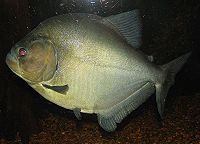
Contact Info
© Copyright 2025 Fishelly - All Rights Reserved
Characidae

The Spotted Piranha is a popular aquarium fish known for its vibrant colors and Challenging of care. It belongs to the family Characidae and is native to the South America
Temperature
23 -27 °C (73.4-80.6°F)
Min. Tanksize
568 Litres (150 US G.)
Water Type
Freshwater
Suitable PH
5.8 - 7.0
Native
South America
Size
35-41 cm (13.8-16.1")
Life Span
8-12 years
Caring
Challenging
Spotted Piranhas are striking, predatory fish known for their sharp teeth and bold personalities. To ensure they remain healthy and happy, it's important to provide them with the right environment.
These fish require a well-sized tank with plenty of space to swim. They are best kept in a large aquarium where they can exhibit their natural hunting behaviors and avoid stress. A minimum tank size of 75 gallons (285 liters) is recommended for a single Spotted Piranha, as they need ample room to move around.
Water quality is crucial for Spotted Piranhas. They thrive in warm water, with temperatures ranging between 75-82°F (24-28°C). It's essential to maintain clean water by performing regular changes and using a reliable filtration system. Keeping the water clean helps prevent diseases and supports their active lifestyle.
A varied diet is important for their health. Spotted Piranhas are carnivorous and need a diet rich in protein. Offer them high-quality pellet foods designed for carnivorous fish, along with occasional live or frozen foods to mimic their natural diet. Proper nutrition supports their growth and overall well-being.
Monitoring their health and behavior is vital. Spotted Piranhas are relatively hardy but keep an eye out for any signs of illness or distress. With the right care, they can be a fascinating and vibrant addition to your aquarium.
Spotted Piranha is a fascinating aquarium fish that stands out with its vibrant colors. It belongs to the family Characidae and is native to the South America.
This species has a care level of Challenging and requires a minimum tank size of 568 Litres (150 US G.). It typically reaches a size of 35-41 cm (13.8-16.1").
Preferred water parameters include a specific gravity (sg) of Freshwater, pH ranging from 5.8 - 7.0, and a temperature between 23 -27 °C (73.4-80.6°F). Additionally, maintaining water hardness within the range of 8-10 °d is essential.
For stocking, the recommended ratio is 1:2 M:F. The Spotted Piranha is widely available and has a diverse diet that includes CarnivoreLive FoodsOther (See article).
With a life span of 8-12 years, this species is known for its very easy care requirements. It is an ideal choice for both beginner and experienced aquarists. Providing a well-maintained tank environment with suitable water conditions will ensure the health and vibrancy of this captivating species.
Do you have any questions about Spotted Piranha Fish?